roof rack NISSAN ROGUE SPORT 2022 Owners Manual
[x] Cancel search | Manufacturer: NISSAN, Model Year: 2022, Model line: ROGUE SPORT, Model: NISSAN ROGUE SPORT 2022Pages: 508, PDF Size: 2.43 MB
Page 12 of 508
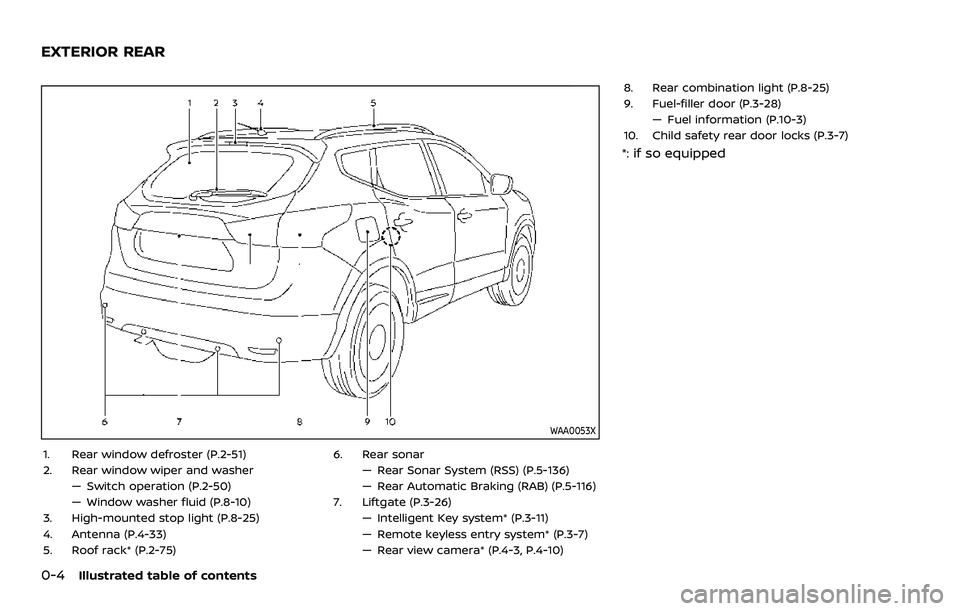
0-4Illustrated table of contents
WAA0053X
1. Rear window defroster (P.2-51)
2. Rear window wiper and washer— Switch operation (P.2-50)
— Window washer fluid (P.8-10)
3. High-mounted stop light (P.8-25)
4. Antenna (P.4-33)
5. Roof rack* (P.2-75) 6. Rear sonar
— Rear Sonar System (RSS) (P.5-136)
— Rear Automatic Braking (RAB) (P.5-116)
7. Liftgate (P.3-26) — Intelligent Key system* (P.3-11)
— Remote keyless entry system* (P.3-7)
— Rear view camera* (P.4-3, P.4-10) 8. Rear combination light (P.8-25)
9. Fuel-filler door (P.3-28)
— Fuel information (P.10-3)
10. Child safety rear door locks (P.3-7)
*: if so equipped
EXTERIOR REAR
Page 84 of 508
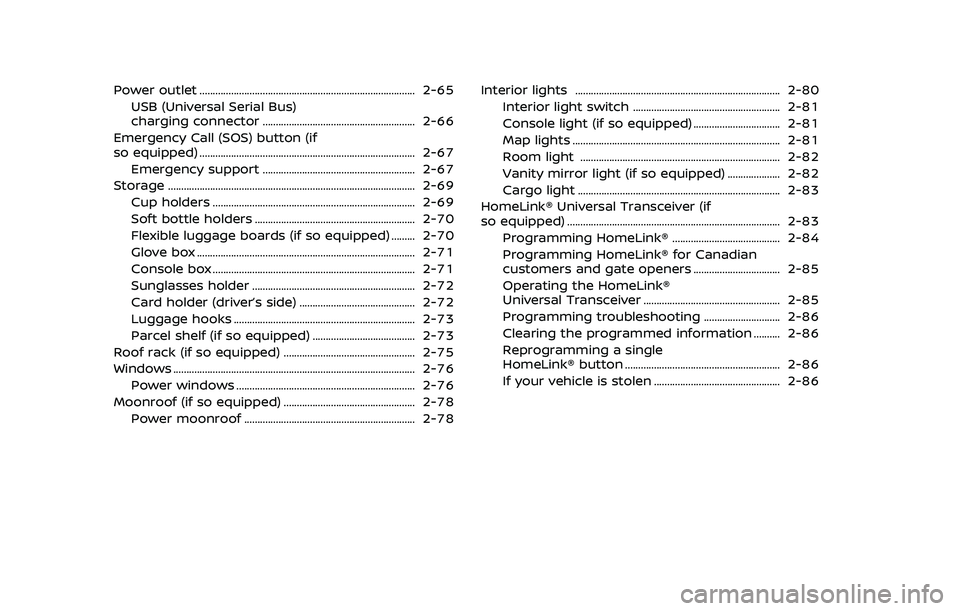
Power outlet ........................................................................\
.......... 2-65USB (Universal Serial Bus)
charging connector .......................................................... 2-66
Emergency Call (SOS) button (if
so equipped) ........................................................................\
.......... 2-67 Emergency support .......................................................... 2-67
Storage ........................................................................\
...................... 2-69 Cup holders ........................................................................\
..... 2-69
Soft bottle holders ............................................................. 2-70
Flexible luggage boards (if so equipped) ......... 2-70
Glove box ........................................................................\
........... 2-71
Console box ........................................................................\
..... 2-71
Sunglasses holder .............................................................. 2-72
Card holder (driver’s side) ............................................ 2-72
Luggage hooks ..................................................................... 2-73
Parcel shelf (if so equipped) ....................................... 2-73
Roof rack (if so equipped) .................................................. 2-75
Windows ........................................................................\
.................... 2-76
Power windows .................................................................... 2-76
Moonroof (if so equipped) .................................................. 2-78 Power moonroof ................................................................. 2-78 Interior lights ........................................................................\
...... 2-80
Interior light switch ........................................................ 2-81
Console light (if so equipped) ................................. 2-81
Map lights ........................................................................\
....... 2-81
Room light ........................................................................\
.... 2-82
Vanity mirror light (if so equipped) .................... 2-82
Cargo light ........................................................................\
..... 2-83
HomeLink® Universal Transceiver (if
so equipped) ........................................................................\
......... 2-83 Programming HomeLink® ......................................... 2-84
Programming HomeLink® for Canadian
customers and gate openers ................................. 2-85
Operating the HomeLink®
Universal Transceiver .................................................... 2-85
Programming troubleshooting ............................. 2-86
Clearing the programmed information .......... 2-86
Reprogramming a single
HomeLink® button ........................................................... 2-86
If your vehicle is stolen ................................................ 2-86
Page 157 of 508
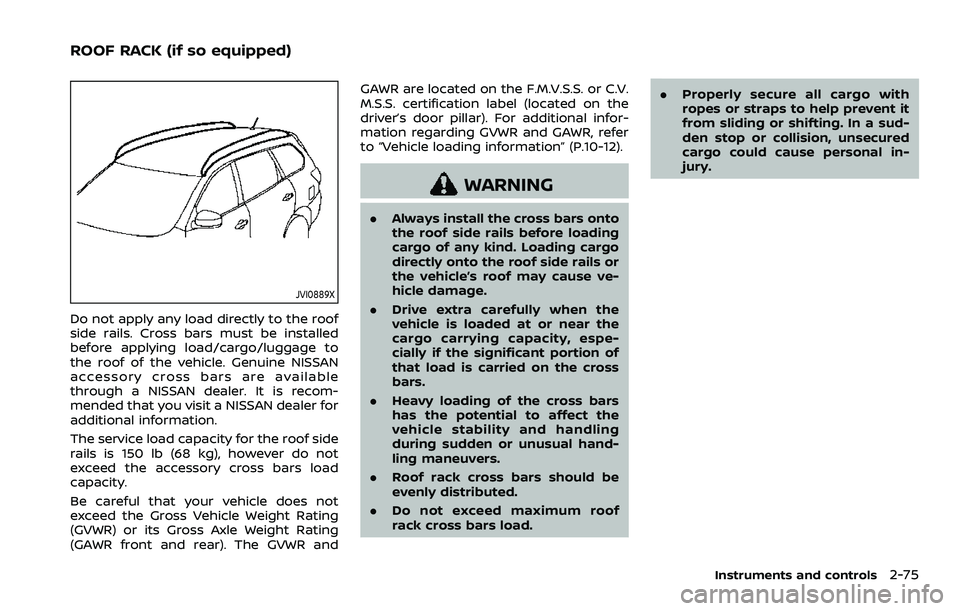
JVI0889X
Do not apply any load directly to the roof
side rails. Cross bars must be installed
before applying load/cargo/luggage to
the roof of the vehicle. Genuine NISSAN
accessory cross bars are available
through a NISSAN dealer. It is recom-
mended that you visit a NISSAN dealer for
additional information.
The service load capacity for the roof side
rails is 150 lb (68 kg), however do not
exceed the accessory cross bars load
capacity.
Be careful that your vehicle does not
exceed the Gross Vehicle Weight Rating
(GVWR) or its Gross Axle Weight Rating
(GAWR front and rear). The GVWR andGAWR are located on the F.M.V.S.S. or C.V.
M.S.S. certification label (located on the
driver’s door pillar). For additional infor-
mation regarding GVWR and GAWR, refer
to “Vehicle loading information” (P.10-12).
WARNING
.
Always install the cross bars onto
the roof side rails before loading
cargo of any kind. Loading cargo
directly onto the roof side rails or
the vehicle’s roof may cause ve-
hicle damage.
. Drive extra carefully when the
vehicle is loaded at or near the
cargo carrying capacity, espe-
cially if the significant portion of
that load is carried on the cross
bars.
. Heavy loading of the cross bars
has the potential to affect the
vehicle stability and handling
during sudden or unusual hand-
ling maneuvers.
. Roof rack cross bars should be
evenly distributed.
. Do not exceed maximum roof
rack cross bars load. .
Properly secure all cargo with
ropes or straps to help prevent it
from sliding or shifting. In a sud-
den stop or collision, unsecured
cargo could cause personal in-
jury.
Instruments and controls2-75
ROOF RACK (if so equipped)
Page 251 of 508
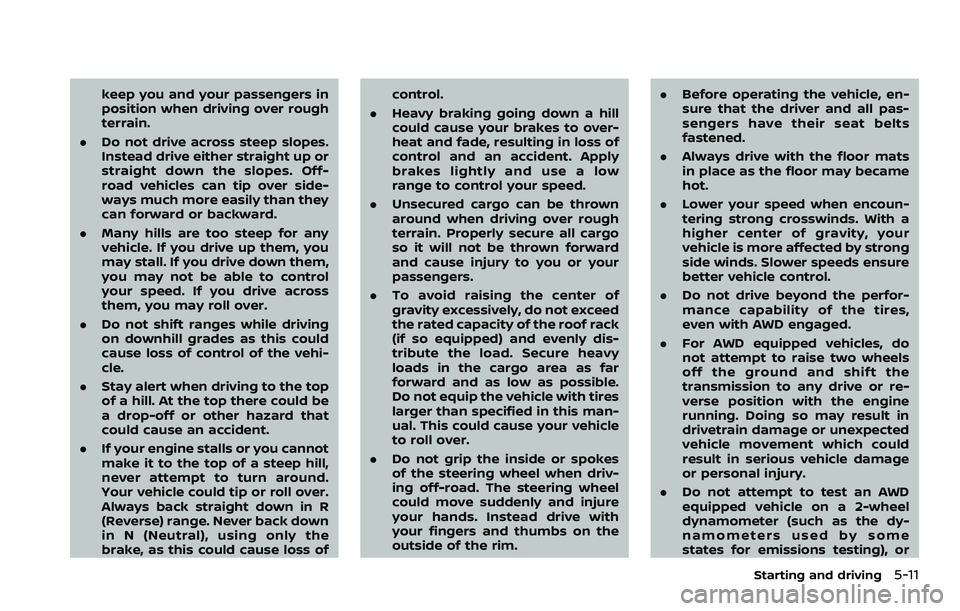
keep you and your passengers in
position when driving over rough
terrain.
. Do not drive across steep slopes.
Instead drive either straight up or
straight down the slopes. Off-
road vehicles can tip over side-
ways much more easily than they
can forward or backward.
. Many hills are too steep for any
vehicle. If you drive up them, you
may stall. If you drive down them,
you may not be able to control
your speed. If you drive across
them, you may roll over.
. Do not shift ranges while driving
on downhill grades as this could
cause loss of control of the vehi-
cle.
. Stay alert when driving to the top
of a hill. At the top there could be
a drop-off or other hazard that
could cause an accident.
. If your engine stalls or you cannot
make it to the top of a steep hill,
never attempt to turn around.
Your vehicle could tip or roll over.
Always back straight down in R
(Reverse) range. Never back down
in N (Neutral), using only the
brake, as this could cause loss of control.
. Heavy braking going down a hill
could cause your brakes to over-
heat and fade, resulting in loss of
control and an accident. Apply
brakes lightly and use a low
range to control your speed.
. Unsecured cargo can be thrown
around when driving over rough
terrain. Properly secure all cargo
so it will not be thrown forward
and cause injury to you or your
passengers.
. To avoid raising the center of
gravity excessively, do not exceed
the rated capacity of the roof rack
(if so equipped) and evenly dis-
tribute the load. Secure heavy
loads in the cargo area as far
forward and as low as possible.
Do not equip the vehicle with tires
larger than specified in this man-
ual. This could cause your vehicle
to roll over.
. Do not grip the inside or spokes
of the steering wheel when driv-
ing off-road. The steering wheel
could move suddenly and injure
your hands. Instead drive with
your fingers and thumbs on the
outside of the rim. .
Before operating the vehicle, en-
sure that the driver and all pas-
sengers have their seat belts
fastened.
. Always drive with the floor mats
in place as the floor may became
hot.
. Lower your speed when encoun-
tering strong crosswinds. With a
higher center of gravity, your
vehicle is more affected by strong
side winds. Slower speeds ensure
better vehicle control.
. Do not drive beyond the perfor-
mance capability of the tires,
even with AWD engaged.
. For AWD equipped vehicles, do
not attempt to raise two wheels
off the ground and shift the
transmission to any drive or re-
verse position with the engine
running. Doing so may result in
drivetrain damage or unexpected
vehicle movement which could
result in serious vehicle damage
or personal injury.
. Do not attempt to test an AWD
equipped vehicle on a 2-wheel
dynamometer (such as the dy-
namometers used by some
states for emissions testing), or
Starting and driving5-11
Page 484 of 508
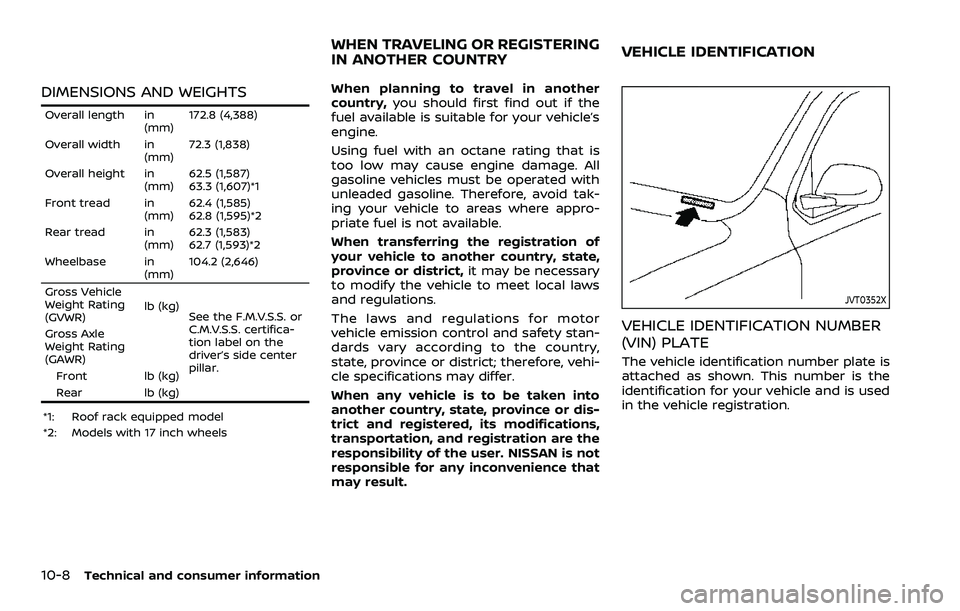
10-8Technical and consumer information
DIMENSIONS AND WEIGHTS
Overall length in(mm)172.8 (4,388)
Overall width in (mm)72.3 (1,838)
Overall height in (mm)62.5 (1,587)
63.3 (1,607)*1
Front tread in (mm)62.4 (1,585)
62.8 (1,595)*2
Rear tread in (mm)62.3 (1,583)
62.7 (1,593)*2
Wheelbase in (mm)104.2 (2,646)
Gross Vehicle
Weight Rating
(GVWR) lb (kg)
See the F.M.V.S.S. or
C.M.V.S.S. certifica-
tion label on the
driver’s side center
pillar.
Gross Axle
Weight Rating
(GAWR)
Front lb (kg)
Rear lb (kg)
*1: Roof rack equipped model
*2: Models with 17 inch wheels
When planning to travel in another
country, you should first find out if the
fuel available is suitable for your vehicle’s
engine.
Using fuel with an octane rating that is
too low may cause engine damage. All
gasoline vehicles must be operated with
unleaded gasoline. Therefore, avoid tak-
ing your vehicle to areas where appro-
priate fuel is not available.
When transferring the registration of
your vehicle to another country, state,
province or district, it may be necessary
to modify the vehicle to meet local laws
and regulations.
The laws and regulations for motor
vehicle emission control and safety stan-
dards vary according to the country,
state, province or district; therefore, vehi-
cle specifications may differ.
When any vehicle is to be taken into
another country, state, province or dis-
trict and registered, its modifications,
transportation, and registration are the
responsibility of the user. NISSAN is not
responsible for any inconvenience that
may result.
JVT0352X
VEHICLE IDENTIFICATION NUMBER
(VIN) PLATE
The vehicle identification number plate is
attached as shown. This number is the
identification for your vehicle and is used
in the vehicle registration.
WHEN TRAVELING OR REGISTERING
IN ANOTHER COUNTRYVEHICLE IDENTIFICATION
Page 503 of 508
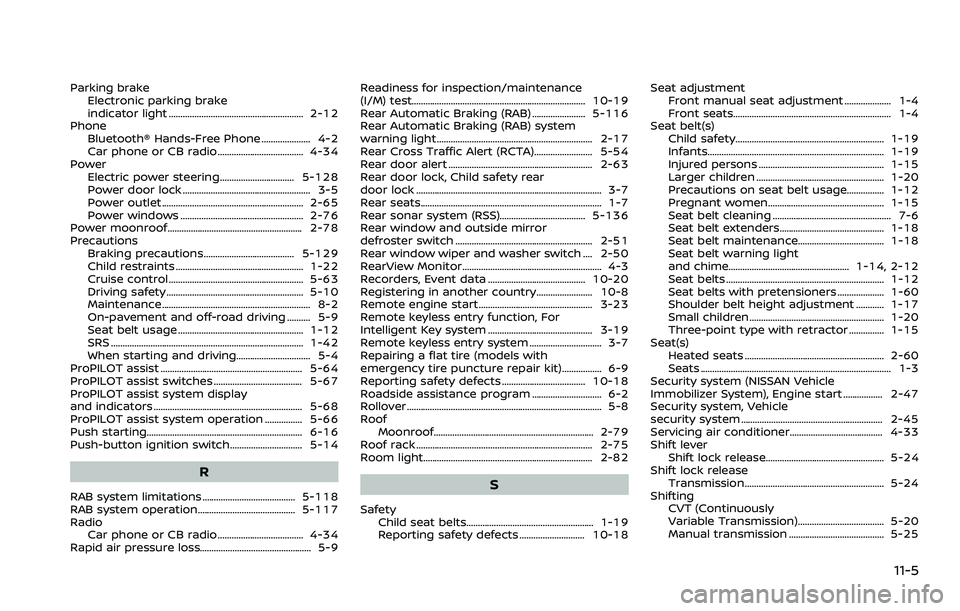
Parking brakeElectronic parking brake
indicator light .......................................................... 2-12
Phone Bluetooth® Hands-Free Phone ..................... 4-2
Car phone or CB radio ..................................... 4-34
Power Electric power steering................................ 5-128
Power door lock ....................................................... 3-5
Power outlet............................................................. 2-65
Power windows ..................................................... 2-76
Power moonroof.......................................................... 2-78
Precautions Braking precautions....................................... 5-129
Child restraints ....................................................... 1-22
Cruise control .......................................................... 5-63
Driving safety ........................................................... 5-10
Maintenance................................................................ 8-2
On-pavement and off-road driving .......... 5-9
Seat belt usage ...................................................... 1-12
SRS ........................................................................\
........... 1-42
When starting and driving................................ 5-4
ProPILOT assist ............................................................. 5-64
ProPILOT assist switches ...................................... 5-67
ProPILOT assist system display
and indicators ................................................................ 5-68
ProPILOT assist system operation ................ 5-66
Push starting................................................................\
... 6-16
Push-button ignition switch............................... 5-14
R
RAB system limitations ........................................ 5-118
RAB system operation.......................................... 5-117
Radio Car phone or CB radio ..................................... 4-34
Rapid air pressure loss................................................ 5-9 Readiness for inspection/maintenance
(I/M) test........................................................................\
... 10-19
Rear Automatic Braking (RAB) ....................... 5-116
Rear Automatic Braking (RAB) system
warning light ................................................................... 2-17
Rear Cross Traffic Alert (RCTA)......................... 5-54
Rear door alert .............................................................. 2-63
Rear door lock, Child safety rear
door lock ........................................................................\
........ 3-7
Rear seats........................................................................\
...... 1-7
Rear sonar system (RSS)..................................... 5-136
Rear window and outside mirror
defroster switch ........................................................... 2-51
Rear window wiper and washer switch .... 2-50
RearView Monitor............................................................ 4-3
Recorders, Event data .......................................... 10-20
Registering in another country........................ 10-8
Remote engine start................................................. 3-23
Remote keyless entry function, For
Intelligent Key system ............................................. 3-19
Remote keyless entry system ............................... 3-7
Repairing a flat tire (models with
emergency tire puncture repair kit) ................. 6-9
Reporting safety defects .................................... 10-18
Roadside assistance program .............................. 6-2
Rollover ........................................................................\
............ 5-8
Roof
Moonroof..................................................................... 2-79
Roof rack ........................................................................\
.... 2-75
Room light........................................................................\
. 2-82S
Safety Child seat belts....................................................... 1-19
Reporting safety defects ............................ 10-18 Seat adjustment
Front manual seat adjustment .................... 1-4
Front seats.................................................................... 1-4
Seat belt(s) Child safety................................................................ 1-19
Infants.................................................................\
........... 1-19
Injured persons ...................................................... 1-15
Larger children ....................................................... 1-20
Precautions on seat belt usage................ 1-12
Pregnant women.................................................. 1-15
Seat belt cleaning ................................................... 7-6
Seat belt extenders............................................. 1-18
Seat belt maintenance..................................... 1-18
Seat belt warning light
and chime.................................................... 1-14, 2-12
Seat belts .................................................................... 1-12
Seat belts with pretensioners .................... 1-60
Shoulder belt height adjustment ............ 1-17
Small children .......................................................... 1-20
Three-point type with retractor ............... 1-15
Seat(s) Heated seats ............................................................ 2-60
Seats ........................................................................\
.......... 1-3
Security system (NISSAN Vehicle
Immobilizer System), Engine start ................. 2-47
Security system, Vehicle
security system ............................................................. 2-45
Servicing air conditioner........................................ 4-33
Shift lever Shift lock release................................................... 5-24
Shift lock release Transmission............................................................ 5-24
Shifting CVT (Continuously
Variable Transmission)..................................... 5-20
Manual transmission ......................................... 5-25
11-5